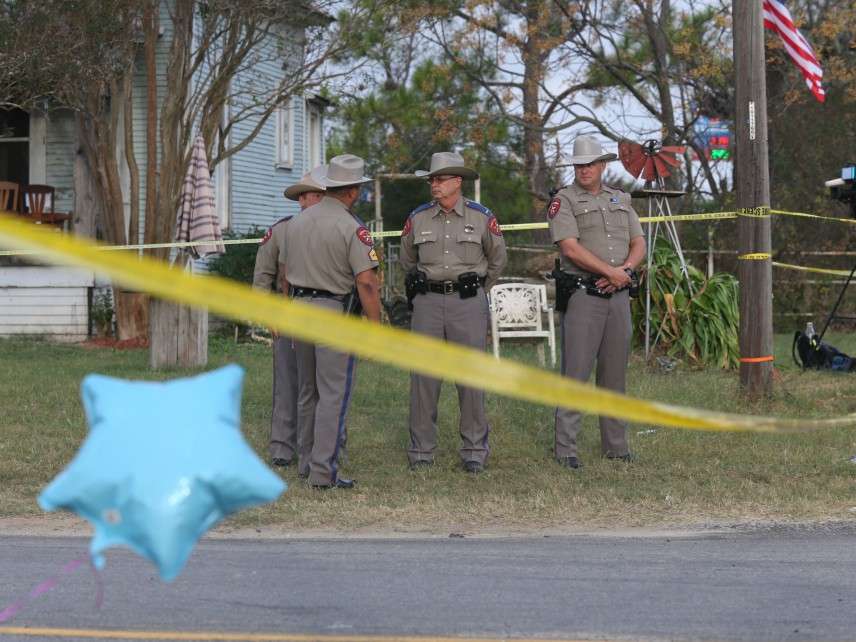Nicholas Kristof Perfects His Mass Shooting Bait and Switch
The New York Times columnist's irrelevant gun control proposals are now accompanied by snazzy graphics.

This week New York Times columnist Nicholas Kristof, who used the October 1 mass shooting in Las Vegas as an excuse to tout a list of admittedly irrelevant gun control proposals, used Sunday's attack at the First Baptist Church in Sutherland Springs, Texas, as an excuse to tout a nearly identical list. This time Kristof has the help of Bill Marsh, graphics editor for the Sunday Review section, so his essay is accompanied by snazzy illustrations, and he presents his ideas as part of a "public health" approach to gun violence that treats firearms the way the government treats cars.
"The left sometimes focuses on 'gun control,' which scares off gun owners and leads to more gun sales," Kristof writes. "A better framing is 'gun safety' or 'reducing gun violence,' and using auto safety as a model—constant efforts to make the products safer and to limit access by people who are most likely to misuse them." But neither the framing nor the graphics can conceal the fact that Kristof is still engaging in the classic gun control—excuse me, gun safety—bait and switch, using outrage at mass shootings to promote policies that have little or nothing to do with them.
Last month Kristof and his editors handled that awkward disjunction awkwardly. The headline promised policies aimed at "Preventing Mass Shootings Like the Vegas Strip Attack," and that is the way he framed the first 14 paragraphs. But in the 15th paragraph Kristof conceded that "it's too soon to know what, if anything, might have prevented the shooting in Las Vegas, and it may be that nothing could have prevented it." Three days later, he tried to make his column seem like less of a non sequitur by adding "ban bump stocks" to his list of solutions. That idea at least had something to do with the Las Vegas massacre, although its effectiveness is more than a little doubtful.
In the revised version of Kristof's October 2 column, a bump stock ban got second billing, right after "universal background checks," which remained in first place even though the Las Vegas shooter underwent background checks and repeatedly passed them because he had no disqualifying criminal or psychiatric record (as is usually true of mass shooters). In this week's column, background checks (you know, like the kind you have to undergo when you buy a car) are still Kristof's top suggestion, despite the fact that the Texas shooter also passed them (although he shouldn't have).
The headline over the new essay, "How to Reduce Shootings," is more ambiguous than the previous headline, since "shootings" could refer to ordinary gun violence as well as the more dramatic examples that grab the headlines. Yet Kristof still presents the piece as a response to mass shootings, saying he wants to "learn lessons from these tragedies, so that there can be fewer of them."
Once again those lessons include, in addition to the wisdom of requiring background checks for all gun transfers and banning bump stocks, the need to prohibit gun purchases by people younger than 21, crack down on straw purchasers, research "smart gun" technology, require safe storage of firearms, and forbid gun possession by people subject to domestic violence restraining orders. Background checks for ammunition purchases have replaced "microstamping of cartridges," and letting people sue gun manufacturers and dealers for the criminal misuse of the products they sell has replaced funding for research on gun violence.
What all these ideas have in common is that, with the partial and dubious exception of a bump stock ban, they are completely disconnected from the details of the crimes to which Kristof is supposedly responding. Nor can any of them reasonably be expected to have a noticeable impact on the frequency or lethality of mass shootings. Kristof eventually concedes as much:
Critics will say that the kind of measures I cite wouldn't prevent many shootings. The Las Vegas carnage, for example, might not have been prevented by any of the suggestions I make.
That's true, and there's no magic wand available. Yet remember that although it is mass shootings that get our attention, they are not the main cause of loss of life. Much more typical is a friend who shoots another, a husband who kills his wife—or, most common of all, a man who kills himself.
So readers who thought Kristof was talking about mass shootings, because that's what he said he was talking about, discover about halfway through the article that he is actually more interested in preventing suicide. Kristof, who promises "the blunt, damning truth" about guns in America, falls short of that goal by presenting his argument in such a misleading way.
Kristof is also telling something less than the blunt truth when he discusses armed self-defense as if the only examples that count are ones in which the attacker is killed. That definition omits the vast majority of such cases, including the armed neighbor who may have prevented more deaths in Texas by injuring (but not killing) the perpetrator after he emerged from the church—the very case that prompted Kristof's regurgitation of familiar gun control proposals.
To his credit, Kristof refrains from endorsing one hoary gun control idea: reviving the federal ban on so-called assault weapons. "The 10-year ban on assault weapons accomplished little," he says, "partly because definitions were about cosmetic features like bayonet mounts (and partly because even before the ban, such guns were used in only 2 percent of crimes)." Kristof's colleagues on the New York Times editorial board, by contrast, are still arguing that "assault weapon bans…would do something to thwart mass shootings."